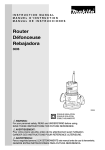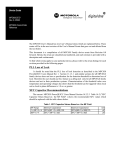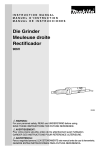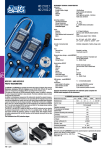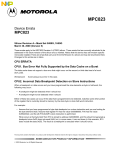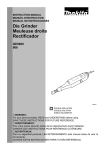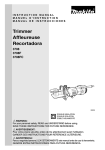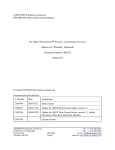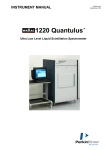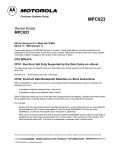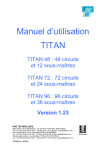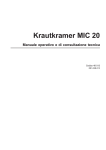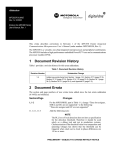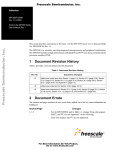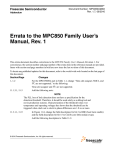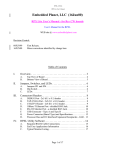Download Device Errata for the MPC850 Family
Transcript
Freescale Semiconductor Document Number: MPC850CE Rev. 7, 11/2007 Errata Device Errata for the MPC850 Family This document is a compilation of all MPC850 family device errata from silicon Revision 0.0 forward. Herein, the errata are classified and numbered, and each erratum is provided with a description and workarounds. Table 1 provides a revision history for this document. Table 1. Document Revision History Rev. No. Date Significant Change(s) 7 11/2007 • Added ESD1 errata. 6 3/2006 • Added CPM18 errata. USB stall handshake • Separates out rev C (End-Of-Life) 5 7/2005 • Updated CPM16 errata. 4 4/2005 • Updated CPM5 errata. • Updated CPM17 errata. Note: Revision 4 replaces MPC850 Family Device Errata Summary (MPC850CESUMM, rev. 2.1), the contents of which are included here. © Freescale Semiconductor, Inc., 2007. All rights reserved. Table 2 lists the silicon revisions of each device. Table 2. Revision Level to Part Marking Cross-Reference Device Rev 0.0 Rev 0.1 Rev 0.2 Rev 0.3 Rev A Rev B 4H97G 0K24A 0K29A 0K45M x Mask Set 0F98S 1F98S 2F98S 3F98S 0H89G 2H89G MPC850 x x x x x MPC850DC x MPC850DE x MPC850DH x x MPC850DSL x MPC850SAR x MPC850SE x x x x MPC850SR x Table 3 summarizes all known errata for the MPC850 family and lists the corresponding silicon revision level to which it applies. A “Y” entry indicates that the erratum applies to a particular revision level, while a “—” entry means it does not apply. Table 3. Summary of MPC850 Silicon Errata and Applicable Revision Silicon Revision Number Name Disposition 0.0 0.1 0.2 0.3 A B Global Some registers are not initialized correctly during Power-Up RESET, HRESET, and SRESET No plans to fix this Y Y Y Y Y Y SIU1 Spurious external bus transaction following PLPRCR write No fix scheduled Y Y Y Y Y Y SIU2 Missed DRAM refresh cycles with external masters Fixed in Rev. B Y Y Y Y Y — SIU3 Lock/unlock function of RSR also locks/unlocks SCCR Fixed in Rev. A Y Y Y Y — — SIU4 Possible external bus hang occurs under certain error conditions No fix scheduled Y Y Y Y Y Y SIU10 RTC/PIT doesn’t count properly No plans to fix this Y Y Y Y Y Y Fixed in Rev. B Y Y Y Y Y — GLL1 SIU CPM CPM1 I2C receive problem in arbitration-lost state Device Errata for the MPC850 Family, Rev. 7 2 Freescale Semiconductor Table 3. Summary of MPC850 Silicon Errata and Applicable Revision (continued) Silicon Revision Number Name Disposition 0.0 0.1 0.2 0.3 A B CPM2 I2C error in FLT bit Fixed in Rev. A Y Y Y Y — — CPM3 I2C master fails to receive after executing read or write Fixed in Rev. B Y Y Y Y Y — CPM4 Receives single-byte buffers after failed transaction Fixed in Rev. A Y Y Y Y Y — CPM5 I2C receiver locks, holding SDA low Work around Y Y Y Y Y Y CPM6 I2C master collision after “double start” Fixed in Rev. B Y Y Y Y Y — CPM7 I2C: short aborted transmission after NACK Fixed in Rev. B Y Y Y Y Y — CPM8 I2C: split receive buffer between loopback and read Fixed in Rev. B Y Y Y Y Y — CPM9 I2C: spurious BUSY errors after reception in I2C master mode Fixed in Rev. B Y Y Y Y Y — CPM10 USB microcode may duplicate first byte for IN token transfer Fixed in Rev. B Y Y Y Y Y — CPM11 Port A pin (PA13) may consume excess current in deep-sleep mode Fixed in Rev. B Y Y Y Y Y — CPM12 Improper USB initialization may cause excess current in deep-sleep mode Fixed in Rev. B Y Y Y Y Y — CPM13 Port B pin (PB25) fails to function as TXD3 Applies only to Rev. A — — — — Y — CPM14 The ERAM4K bit in the RISC Microcode Development Support Control Register (RMDS) is erroneously cleared No fix scheduled Y Y Y Y Y Y CPM15 USB underrun when ATM or Ethernet function is used in conjunction with USB No fix scheduled Y Y Y Y Y Y CPM16 USB endpoint lock up Work around Y Y Y Y Y Y CPM17 USB occasionally ignores tokens, violates USB protocol by providing incorrect responses, etc. Work around Y Y Y Y Y Y CPM18 Stall handshake Work around Y Y Y Y Y Y Device Errata for the MPC850 Family, Rev. 7 Freescale Semiconductor 3 Table 3. Summary of MPC850 Silicon Errata and Applicable Revision (continued) Silicon Revision Number Name Disposition 0.0 0.1 0.2 0.3 A B No fix scheduled Y Y Y Y Y Y General G1 Core operation is limited to a 3.0V minimum G2 Higher than expected Keep Alive Power (KAPWR) current when main power (VDDH & VDDL) is removed Fixed in Rev. 0.2 Y Y — — — — G3 EXTCLK and CLKOUT clocks may not be in phase in half-speed bus mode Fixed in Rev. B Y Y Y Y Y — G4 Potential problems caused by skew between EXTCLK and CLKOUT Fixed in Rev. B Y Y Y Y Y — G5 Breakdown voltage for XFC pin less than Motorola-imposed requirements Fixed in Rev. A Y Y Y Y — — G6 Active pullup drivers switch to high-impedance too early Fixed in Rev. A Y Y Y Y — — G7 Restriction of open collector pull up No fix scheduled Y Y Y Y Y Y CPU1 Bus error unsupported by the data cache burst No fix scheduled Y Y Y Y Y Y CPU2 D-Cache presents valid data when parity error present on a burst Fixed in Rev. A Y Y Y Y — — CPU3 Incorrect data breakpoint detection on store instructions No fix scheduled Y Y Y Y Y Y CPU4 Program trace mechanism error No fix scheduled Y Y Y Y Y Y CPU5 Instruction cache replacement policy bug Fixed in Rev. 0.3 Y Y Y — — — CPU6 Instruction MMU bug at page boundaries in show-all mode No fix scheduled Y Y Y Y Y Y CPU7 Possible data cache corruption when writing SPRs Fixed in Rev. A Y Y Y Y — — CPU8 Branch prediction with sequential branch instructions Fixed in Rev. B Y Y Y Y Y — CPU9 Missed instruction after conditional branch Fixed in Rev. B Y Y Y Y Y — CPU10 Instruction sequencer error when modifying MSR with interrupts enabled Fixed in Rev. B Y Y Y Y Y — CPU11 Possible excess current consumption in deep sleep mode No plans to fix Y Y Y Y Y Y CPU ATM Device Errata for the MPC850 Family, Rev. 7 4 Freescale Semiconductor Table 3. Summary of MPC850 Silicon Errata and Applicable Revision (continued) Silicon Revision Number Name Disposition 0.0 0.1 0.2 0.3 A B ATM1 APCO interrupts cannot be masked No fix scheduled Y Y Y Y Y Y ATM2 CPM lockup when issuing APC_BYPASS when TX queue full No fix scheduled Y Y Y Y Y Y ATM3 CPM lockup when issuing APC_BYPASS when TX queue full Fixed in Rev. B Y Y Y Y Y — No plans to fix Y Y Y Y Y Y ESD ESD1 200 Volts ESD Machine Model (MM) requirements on certain Parallel I/O pins is not met Global GLL1 Some registers are not initialized correctly during Power-Up RESET, HRESET, and SRESET Description: The following table is provided to clarify/correct the power-on RESET value of many of the registers and lists whether each register is affected by HRESET* and/or SRESET*. The table applies for the MPC850 Family, the MPC855T, the MPC857T, the MPC860 Family, and the MPC862 Family. Table 4. Power-On Reset of Registers REGISTER Value at Power-On RESET* Affected by HRESET* Affected by SRESET* SIUMCR 01200000 YES NO SYPCR FFFFFF07 YES NO SWSR 0 YES YES SIPEND 0000xxxx YES YES SIMASK 0000xxxx YES YES SIEL 0000xxxx YES NO SIVEC (xx11)(11xx)xxxxxx YES YES TESR XXXX0000 YES YES SDCR 0 YES NO PBR0 x NO NO POR0 x NO NO PBR1 x NO NO Device Errata for the MPC850 Family, Rev. 7 Freescale Semiconductor 5 Table 4. Power-On Reset of Registers (continued) REGISTER Value at Power-On RESET* Affected by HRESET* Affected by SRESET* POR1 x NO NO PBR2 x NO NO POR2 x NO NO PBR3 x NO NO POR3 x NO NO PBR4 x NO NO POR4 x NO NO PBR5 x NO NO POR5 x NO NO PBR6 x NO NO POR6 x NO NO PBR7 x NO NO POR7 x NO NO PGCRA 0 YES NO PGCRB 0 YES NO PSCR x NO NO PIPR ??00??00 YES YES PER 0 YES YES BR0 XXXXX(??00)0(000?) YES NO OR0 00000FF4 YES NO BR1 XXXXXX(xx00)0 YES NO OR1 XXXXXXX(xxx0) YES NO BR2 XXXXXX(xx00)0 YES NO OR2 XXXXXXX(xxx0) YES NO BR3 XXXXXX(xx00)0 YES NO OR3 XXXXXXX(xxx0) YES NO BR4 XXXXXX(xx00)0 YES NO OR4 XXXXXXX(xxx0) YES NO BR5 XXXXXX(xx00)0 YES NO OR5 XXXXXXX(xxx0) YES NO BR6 XXXXXX(xx00)0 YES NO OR6 XXXXXXX(xxx0) YES NO Device Errata for the MPC850 Family, Rev. 7 6 Freescale Semiconductor Table 4. Power-On Reset of Registers (continued) REGISTER Value at Power-On RESET* Affected by HRESET* Affected by SRESET* BR7 XXXXXX(xx00)0 YES NO OR7 XXXXXXX(xxx0) YES NO MAR x NO NO MCR (xx00)0(x000)0(xxx0)X(00xx)X YES NO MAMR xx001000 YES NO MBMR xx001000 YES NO MSTAT 0 YES NO MPTPR 0200 YES NO MDR x NO NO TBSCR 0 YES NO TBREFA x NO NO TBREFB x NO NO RTCSC 00(000x)(000x) YES YES RTC x NO YES RTSEC x NO YES RTCAL x NO NO PISCR 0 YES NO PITC x NO NO PITR x N/A N/A SCCR 0(000?)(?000)(0??0)0000 YES NO PLPRCR ???0(0100)000 YES YES RSR 0 YES YES TBSCRK x YES YES TBREFAK x YES YES TBREFBK x YES YES TBK x YES YES RTCSCK x YES YES RTCK x YES YES RTSECK x YES YES RTCALK x YES YES PISCRK x YES YES PITCK x YES YES Device Errata for the MPC850 Family, Rev. 7 Freescale Semiconductor 7 Table 4. Power-On Reset of Registers (continued) REGISTER Value at Power-On RESET* Affected by HRESET* Affected by SRESET* SCCRK x YES YES PLPRCRK x YES YES RSRK x YES YES I2MOD 0 YES YES I2ADD x NO NO I2BRG FFFF YES NO I2COM 0 YES YES I2CER 0 YES YES I2CMR 0 YES YES SDAR x NO NO SDSR 0 YES YES SDMR 0 YES YES IDSR1 0 YES YES IDMR1 0 YES YES IDSR2 0 YES YES IDMR2 0 YES YES CIVR 0 YES YES CICR 0 YES NO CIPR 0 YES YES CIMR 0 YES YES CISR 0 YES YES PADIR 0 YES NO PAPAR 0 YES NO PAODR 0 YES NO PADAT x NO NO PCDIR 0 YES NO PCPAR 0 YES NO PCSO 0 YES NO PCDAT x NO NO PCINT 0 YES NO PDDIR 0 YES NO PDPAR 0 YES NO Device Errata for the MPC850 Family, Rev. 7 8 Freescale Semiconductor Table 4. Power-On Reset of Registers (continued) REGISTER Value at Power-On RESET* Affected by HRESET* Affected by SRESET* PDDAT x NO NO TGCR 0 YES YES TMR1 0 YES YES TMR2 0 YES YES TRR1 FFFF YES YES TRR2 FFFF YES YES TCR1 0 YES YES TCR2 0 YES YES TCN1 0 YES YES TCN2 0 YES YES TMR3 0 YES YES TMR4 0 YES YES TRR3 FFFF YES YES TRR4 FFFF YES YES TCR3 0 YES YES TCR4 0 YES YES TCN3 0 YES YES TCN4 0 YES YES TER1 0 YES YES TER2 0 YES YES TER3 0 YES YES TER4 0 YES YES CPCR 0 YES YES RCCR 0 YES NO RCTR1 NA YES YES RCTR2 NA YES YES RCTR3 NA YES YES RCTR4 NA YES YES RTER 0 YES YES RTMR 0 YES YES BRGC1 0 YES NO BRGC2 0 YES NO Device Errata for the MPC850 Family, Rev. 7 Freescale Semiconductor 9 Table 4. Power-On Reset of Registers (continued) REGISTER Value at Power-On RESET* Affected by HRESET* Affected by SRESET* BRGC3 0 YES NO BRGC4 0 YES NO GSMR_L1 0 YES YES GSMR_H1 0 YES YES PSMR1 0 YES YES TODR1 0 YES YES DSR1 7E7E YES YES SCCE1 0 YES YES SCCM1 0 YES YES SCCS1 0 YES YES GSMR_L2 0 YES YES GSMR_H2 0 YES YES PSMR2 0 YES YES TODR2 0 YES YES DSR2 7E7E YES YES SCCE2 0 YES YES SCCM2 0 YES YES SCCS2 0 YES YES GSMR_L3 0 YES YES GSMR_H3 0 YES YES PSMR3 0 YES YES TODR3 0 YES YES DSR3 7E7E YES YES SCCE3 0 YES YES SCCM3 0 YES YES SCCS3 0 YES YES GSMR_L4 0 YES YES GSMR_H4 0 YES YES PSMR4 0 YES YES TODR4 0 YES YES DSR4 7E7E YES YES SCCE4 0 YES YES Device Errata for the MPC850 Family, Rev. 7 10 Freescale Semiconductor Table 4. Power-On Reset of Registers (continued) REGISTER Value at Power-On RESET* Affected by HRESET* Affected by SRESET* SCCM4 0 YES YES SCCS4 0 YES YES SMCMR1 0 YES YES SMCE1 0 YES YES SMCM1 0 YES YES SMCMR2 0 YES YES SMCE2 0 YES YES SMCM2 0 YES YES SPMODE 0 YES YES SPIE 0 YES YES SPIM 0 YES YES SPCOM 0 YES YES PIPC 0 YES NO PTPR 0 YES NO PBDIR xxx(xx00)0000 YES NO PBPAR xxx(xx00)0000 YES NO PBODR 0 YES NO PBDAT x YES YES SIMODE 0 YES YES SIGMR 0 YES NO SISTR 0 YES NO SICMR 0 YES YES SICR 0 YES NO SIRP 0 YES YES Legend: x or X = “don’t care” in either bits, nibbles, or the entire register. 0 = a single zero indicates the entire register is reset to zeros. ( ) = isolates bits of a nibble of the register. ? = a don’t care for POR, but if this register is affected by HRESET* or SRESET*, indicates that the value will remain the same as what it was before the reset occurred. NA = Not Applicable, indicates that this register has no POR value. Projected Solution: Not scheduled to be corrected. Device Errata for the MPC850 Family, Rev. 7 Freescale Semiconductor 11 SIU SIU1 Spurious external bus transaction following PLPRCR write Description: This erratum only affects some designs which execute code from synchronous memories or bus slaves. Spurious external bus transactions can occur after executing a store to the PLPRCR register which changes the PLL multiplication factor (MF bits). This store causes the PLL to freeze the clocks while another external bus access is already visible on the pins of the chip. This appears externally as a transaction which begins, has its clocks frozen, and then is abruptly aborted without following the bus protocol. This behavior will only affect systems with bus slaves that implement synchronous state machines that are sensitive to bus protocol violations. Synchronous DRAMs are not affected, and synchronous bus slaves that ignore bus signals when not selected (for example, Tundra QSPAN) are not affected. The only cases in which this erratum will cause problems are if: 1. The device is executing code from a slave which implements a state machine dependent on the PowerPC bus protocol, where that state machine might “get lost.” 2. There is an external device which snoops the PowerPC bus and implements a state machine; this state machine might “get lost.” The impact of this erratum has been deemed minimal, and it will therefore not be corrected. Work Arounds: If the behavior described above is unacceptable in the system, the following procedure can be used to avoid the spurious external bus transaction: The instruction which performs the store to the PLPRCR should be on a burst-aligned address with at least one isync instruction following it. The Instruction Cache should be enabled while executing this sequence. Example code performing this is as follows: bl .unlock_all bl .invalid_all bl .cache_en # icache initialization . . . . lis 3, 0x0050 ori 3, 3, 0x00C0 b st_algn Device Errata for the MPC850 Family, Rev. 7 12 Freescale Semiconductor .org main + 0x0200 ## st_algn: stw 3, PLPRCR_OFFSET(4) # burst aligned address isync # isync lis 3, 0x1234 # Any instruction lis 3, 0x1234 # Any instruction Projected Solution: No scheduled fix. Device Errata for the MPC850 Family, Rev. 7 Freescale Semiconductor 13 SIU SIU2 Missed DRAM refresh cycles with external masters Description: IF the MPC850 is using internal arbitration (SIUMCR[EARB]=0) AND the arbitration request level (SIUMCR[EARP]) for external masters is greater than zero, THEN if a request by an external master (signalled by DREQ) occurs simultaneously with a request from the DRAM refresh controller, then the request from the DRAM refresh controller will be cancelled. This will result in a missed refresh cycle. In a system with many bus requests by external masters, this can potentially result in the cancellation of all DRAM refreshes. Work Arounds: 1. Program SIUMCR[EARP] to zero. 2. Increase the refresh rate to compensate for the potential cancellation of refresh cycles. Treated probabilistically, it should be possible to keep the refresh rate above a minimum intended rate. This is difficult to model exactly, but can be roughly estimated. For the following discussion: N = proportion of bus bandwidth used by internal MPC850 masters (other than refresh) E = proportion of bus bandwidth used by external masters A = proportion of bus bandwidth available for refresh By definition, N + E + A = 1. The proportion of time that a refresh request can occur is (E+A). The probability that a refresh request will be cancelled is E / (E+A). If P is the probability that the refresh request will be successfully transacted, the P = 1 - [E / (E+A)]. Therefore, to compensate for cancellation of requests, increase the refresh request rate by 1/P. For a numerical example, assume that internal and external masters each use 30% of the bus bandwidth. Thus, N = 0.3, E = 0.3, and A = 0.4. In this example, set the refresh rate to 1.75 times the intended rate. Note, however, that this workaround becomes impractical as A approaches zero. 3. Implement a software-controlled refresh, initiated by a periodic timer request. The user should program the PIT timer (or a CPM timer) to provide a periodic interrupt. The interrupt service routine should incorporate a software routine to refresh a memory block. This software refresh routine can consist of either reads from the appropriate DRAM page or, more simply, execution of the UPM’s refresh routine via a RUN command to the MCR. The second method is recommended, as it is simpler and uses the DRAM’s internal counter to keep track of the row to be refreshed. The user should choose the size of memory block to be refreshed per interrupt in order to minimize the impact of the interrupt overhead. Let’s look at an example at one extreme. Assume a system with two 4Mx32 DRAM banks controlled by CS2 and CS3. Each bank has 2048 pages (rows) and each page must be refreshed every 15.6 ms. If the UPM refresh pattern called by the software refresh routine is set up to loop 16 times (and therefore can refresh 16 rows per call), the timer interrupt should occur every Device Errata for the MPC850 Family, Rev. 7 14 Freescale Semiconductor (16/2048)*15.6ms, or approximately 120µs. If one iteration of the UPM refresh pattern is 5 clocks, the total time required to execute the software refresh routine (plus overhead for fetching instructions) for both banks is 5*16*2+20 = 180 clocks. Assuming an interrupt service routine entry/exit overhead of 1200 clocks, each refresh interrupt would take approximate 1400 clocks, or 28µs (assuming a 50MHz system clock). An ISR consuming 28µs out of every 120µs period would consume 23.3% of the CPU, with 8200 interrupts per second. At the other extreme, we could refresh the entire memory (2048 refresh cycles per bank) every 15.6ms. In this case, the software refresh routine would require 1200+(2048/16*180) = 24240 clocks, or 485µs. In this case, the ISR would consume 485µs out of every 15.6ms, or 3% of the CPU, and would require only 64 interrupts per second. However, system tasks would be stalled for 485µs while waiting for the refresh task to complete. The best compromise lies between. For example, at 64 pages per interrupt, the software refresh routine will consume 1200+(64/16*18) = 1920 clocks, or 38.5µs. The CPU bandwidth consumed will be 38.5µs/(120µs*4) or about 8%, with about 2000 interrupts per second. Example code implementing this software refresh follows below: #================================================================= #This code initialize the PIT timers to interrupt (number 0) every ~24000 clocks xor 10,0,0 ori 10,10,0xaa33 oris 10,10,0x55cc stw 10,RTSECK_OFFSET(20) # OPEN RTC KEY stw 10,RTSEC_OFFSET(20) # RESET RTC divider addis 10,10,0x80 stw 10,PISCR_OFFSET(20) # CLEAR PIT INT bit lwz 7,SCCR_OFFSET(20) andi. 8,7,0xffff andis. 9,7,0xff7f or 7,8,9 oris 7,7,0x0100 stw 7,SCCR_OFFSET(20) # RTC_CLK = SYSCLK/512 xor 9,0,0 addis 9,9,0x2f stw 9,PITC_OFFSET(20) # Int every 24000 system clocks xor 10,0,0 addis 10,10,0x85 stw 10,PISCR_OFFSET(20) # PIT enable sync #================================================================= #The interrupt routine should include this code : #================================================================= INT0 : lhz 9,PISCR_OFFSET(20) # sth 9,PISCR_OFFSET(20) # CLEAR PIT INT bit andi. 9,9,0x80 bc 0x4,2,INT0_L xor 8,8,8 Device Errata for the MPC850 Family, Rev. 7 Freescale Semiconductor 15 ori 8,8,0x0030 oris 8,8,0x8080 # Refresh CS_0 by MCR command stw 8,MCR_OFFSET(20) # MCR(UPMB,0x30) stw 8,MCR_OFFSET(20) # MCR(UPMB,0x30) stw 8,MCR_OFFSET(20) # MCR(UPMB,0x30) stw 8,MCR_OFFSET(20) # MCR(UPMB,0x30) ori stw stw stw stw 8,8,0x2000 # Refresh CS_1 by MCR command 8,MCR_OFFSET(20) # MCR(UPMB,0x30) 8,MCR_OFFSET(20) # MCR(UPMB,0x30) 8,MCR_OFFSET(20) # MCR(UPMB,0x30) 8,MCR_OFFSET(20) # MCR(UPMB,0x30) Projected Solution: Corrected in Revision B. Device Errata for the MPC850 Family, Rev. 7 16 Freescale Semiconductor SIU SIU3 Lock/unlock function of RSR also locks/unlocks SCCR Description: When the RSR is locked or unlocked via the RSRK register, the same function is also performed on the SCCR. Work Arounds: This erratum should not affect user software as long as one is aware of it. In order to avoid possible software errors due to this (if, for example, the associated code statements were reordered by the user in a code revision), as a code convention one should always perform the unlock-modify-lock operations in immediate succession on individual registers. That is, unlock the register, modify it, then lock it. Projected Solution: Corrected in Revision A. Device Errata for the MPC850 Family, Rev. 7 Freescale Semiconductor 17 SIU SIU4 Possible external bus hang occurs under certain error conditions Description: The external bus cycle may hang when the following sequence of events occur: 1. A transaction on the external bus ends as a result of an assertion of TEA or a bus monitor timeout occurs. 2. The next transaction also ends as result of an assertion of TEA or a bus monitor timeout occurs. (burt 300) Work Arounds: None. Projected Solution: No scheduled fix. Device Errata for the MPC850 Family, Rev. 7 18 Freescale Semiconductor SIU SIU10 RTC/PIT doesn’t count properly Description: The periodic interrupt timer (PIT) consists of a 16-bit counter clocked by the PITRCLK clock supplied by the clock RTCLK (Real time clock). The 16-bit counter counts down to zero when loaded with a value from the PITC. After the timer reaches zero, the PS bit is set and an interrupt is generated if the PIE bit is a logic one. The user can program the RTC and PIT clock to be divided by 4 or 256 (depending on SCCR[RTDIV]). When the RTC clock is divided by 4, an interrupt will not occur due to a bug in the rtclk_sync_raw logic. The rtclk_sync_raw is the real time clock for the RTC timers, and its frequency is the same as rtclk_raw. If the pll output clock is enabled and not in reset state, and the timer has not expired, then the rtclk_sync_raw clock has a 25% duty cycle synchronous with system T4 tick, otherwise this clock is the same as rtclk_raw. From the ckpspcl schematics, rtclk_raw also selects rtclk_sync_raw. There is no issue in the above statement when the pre-divider is set to 256 clocks, this is because the select line is slower then the selected clock source. But, when the pre-divider is set to 4, there is suppose to be a rtclk_sync_raw edge every 2 clocks. The rising edge of this clock will disappear due to a race between rtclk_sync_raw (as the select line) and the ckp_rtclk_sysd (as the data for the mux). At room temperature, this will generate a spike signal, and at hot temperature, this will degrade and disappear. When this happens, the RTC will not count properly, and no interrupt will occur. Work Arounds: None. Projected Solution: Not to be corrected. Device Errata for the MPC850 Family, Rev. 7 Freescale Semiconductor 19 CPM CPM1 I2C receive problem in arbitration-lost state Description: If the MPC850 I2C master transmitter loses arbitration to another I2C master which is transmitting to the MPC850, the 860 receiver will not accept the message (address byte not acknowledged). Work Arounds: 1. Avoid multimaster configuration. 2. The operation should be retried by the other master through software. Projected Solution: Corrected in Revision B. Device Errata for the MPC850 Family, Rev. 7 20 Freescale Semiconductor CPM CPM2 I2C error in FLT bit Description: An error will occur if the FLT bit is set to turn on the digital filter for the I2C. The digital filter is activated by setting the FLT bit in the I2C mode register and is turned off at reset. (However, note that this digital filter is not required for normal operation. The MPC8xx I2C is fully compliant to the I2C specification even without this digital filter.) Work Arounds: Do not turn on the digital filter for I2C clock filter. Projected Solution: Corrected in Revision A. Device Errata for the MPC850 Family, Rev. 7 Freescale Semiconductor 21 SIU CPM3 I2C master fails to receive after executing read or write Description: If the I2C channel is in master mode, after the I2C channel performs a transaction (read or write command), the I2C channel will fail to receive a transmission from another master. It will respond with NACK. Furthermore, after the failed reception, if the I2C master then attempts to perform another transaction (read or write command), the transaction will fail with an underrun error. Work Arounds: After the master I2C channel completes its transmission, disable and re-enable the channel in the I2MOD register (thereby resetting it). Projected Solution: Corrected in Revision B. Device Errata for the MPC850 Family, Rev. 7 22 Freescale Semiconductor CPM CPM4 Receives single-byte buffers after failed transaction Description: A. If the I2C channel is in master mode, then: If the I2C master attempts a transaction (read or write command) which receives a NACK, AND the I2C master then attempts to execute a read to another slave, THEN the master will receive the first byte of the slave’s message in one buffer and will close the BD, and then will continue to receive the rest of the message in the next BDs. This reception of the first byte in a single-byte buffer will happen regardless of the MRBLR. B. If the I2C channel is in slave mode, then: If the I2C slave responds to a read command (for example, performs a transmission), AND the I2C slave then responds to a write command (for example, performs a reception), THEN the I2C slave will receive the first byte of the master’s message in one buffer and will close the BD, and then will continue to receive the rest of the message in the next BDs. This reception of the first byte in a single-byte buffer will happen regardless of the MRBLR. Work Arounds: After the I2C channel performs a transmission (master read or write, or slave response to read), disable and re-enable the channel in the I2MOD register (thereby resetting it). Projected Solution: Corrected in Revision B. Device Errata for the MPC850 Family, Rev. 7 Freescale Semiconductor 23 CPM CPM5 I2C receiver locks, holding SDA low Description: The I2C receiver may lock up, holding the I2CSDA line low, in a system that has slow rise/fall time on the I2C clock (I2CSCL) if the environment is noisy. Work Arounds: Set the I2C predivider to 32 (by setting I2MOD[PDIV]=00), and restrict rise/fall time of I2CSCL to 0.5 µs. In addition to this, for MPC850 revision B.0 and later, enable the digital filter via the I2MOD[FLT]. [For previous revisions of the MPC850, the digital filter is not functional.] Projected Solution: No scheduled fix. Device Errata for the MPC850 Family, Rev. 7 24 Freescale Semiconductor CPM CPM6 I2C master collision after “double start” Description: The following situation will result in the I2C controller colliding with the transmission of another master: 1. Another I2C master performs a “master write” to the I2C controller of the MPC850. 2. The I2C controller of the MPC850 is waiting for the I2C bus to become idle in order to become the master and perform a transaction. 3. The other I2C master asserts a new “START” condition without asserting a “STOP” condition. In this case, the I2C master of the MPC850 will incorrectly interpret the new “START” condition as generated by itself, and will therefore drive the I2C bus concurrently with the other master. Work Arounds: Avoid performing back-to-back START conditions on the I2C bus. Projected Solution: Corrected in Revision B. Device Errata for the MPC850 Family, Rev. 7 Freescale Semiconductor 25 CPM CPM7 I2C: short aborted transmission after NACK Description: The following situation will cause the I2C controller of the MPC850 to send a short aborted transmission: 1. The MPC850’s I2C controller performs a transaction, transmitting a buffer which has no STOP condition at the end. The next buffer (not yet transmitted) will issue a START condition, producing back-to-back transactions without an intervening STOP (also known as “double start”). 2. The MPC850’s I2C controller receives a NACK on the last or next-to-last byte of the buffer. If this case occurs, then the MPC850’s I2C controller will assert a STOP condition (as expected by the I2C protocol). However, when software subsequently issues a new start command (I2COM = 0x81), the I2C master will begin its next transaction erratically. It will issue a START condition and drive one bit of the message, then drive a new START condition and restart the transmission (including the first bit). Work Arounds: Do not set up the MPC850’s I2C controller to perform “double start.” Projected Solution: Corrected in Revision B. Device Errata for the MPC850 Family, Rev. 7 26 Freescale Semiconductor CPM CPM8 I2C: split receive buffer between loopback and read Description: IF the MPC850’s I2C master performs a loopback transaction (for example, a master write to its own I2C address or a master write to the General Call address with General Call reception enabled). AND the MPC850’s I2C master then performs a master read transaction THEN the receive buffer used for the loopback transaction will not be closed after the loopback transaction. Instead, it will be closed after the first byte of the read transaction is received. Thus, the received data from the read transaction will be split between the loopback buffer and the intended receive buffer. Work Arounds: Avoid performing loopback transactions during normal operation. Projected Solution: Corrected in Revision B. Device Errata for the MPC850 Family, Rev. 7 Freescale Semiconductor 27 CPM CPM9 I2C: spurious BUSY errors after reception in I2C master mode Description: IF the MPC850’s I2C controller is configured as an I2C master AND the I2C controller is the target of another master’s write, THEN after the MPC850 receives the data from the master (and thus closes the receive buffer appropriately), it will attempt to open the next receive buffer (even though there is no receive data). If there is no buffer available, it will generate a BUSY error. Work Arounds: Ignore BUSY errors in this case. Projected Solution: Corrected in Revision B. Device Errata for the MPC850 Family, Rev. 7 28 Freescale Semiconductor CPM CPM10 USB microcode may duplicate first byte for IN token transfer Description: If an IN token for an end-point is received exactly between the time the first byte was written to the FIFO and the time the second byte is written to the FIFO, then the next IN token will be answered with a frame that has the first byte duplicated. This is caused by the microcode aborting the in_frame state when the IN token is received and the FIFO is not full. (burt_xxx) Work Arounds: A microcode patch is available and will be placed on the MPC850 web site. This microcode patch will ignore the fifo_not_ready error if FIFO filling has already started. The microcode package includes a README document, upatch (micro assembler source), upatcch.map (listing), upatch.c (C-format object code), and an upatch.srx (S-record format object file). Projected Solution: Corrected in Revision B. Device Errata for the MPC850 Family, Rev. 7 Freescale Semiconductor 29 CPM CPM11 Port A pin (PA13) may consume excess current in deep-sleep mode Description: When the Port A pin PA13 is configured as the SCC2 function RXD2 and the IrDA logic is not enabled (for example,,the EN=0 in the IRMODE register), then the MPC850 may consume excess current due to internal contention after entering deep-sleep mode. Other than the approximate 1mA of excess current, there are no operational issues. Work Arounds: Before entering deep-sleep mode, configure PA13 as a general-purpose input. When you exit deep-sleep mode, reconfigure PA13 as the SCC2-controlled RXD2, as required. Projected Solution: Corrected in Revision B. Device Errata for the MPC850 Family, Rev. 7 30 Freescale Semiconductor CPM CPM12 Improper USB initialization may cause excess current in deep-sleep mode Description: An initialization problem in the USB block might cause excess current in the deep-sleep mode, typically around 500µA. Work Arounds: As part of the power-on initialization sequence, the software should enable the baud rate generator clock1 (BRGC1) by setting the EN bit to 1 and leaving it set for at least 16 system clocks before changing the serial interface clock route register from its default value (0x00000000). Projected Solution: Corrected in Revision B. Device Errata for the MPC850 Family, Rev. 7 Freescale Semiconductor 31 CPM CPM13 Port B pin (PB25) fails to function as TXD3 Description: If Port B pin PB25 is configured to function as TXD3, it will fail to transmit data. Work Arounds: Connect a pullup resistor to Port B pin PB25 if it is configured to function as TXD3. The pin will then transmit normally. Projected Solution: Corrected in Revision B. Device Errata for the MPC850 Family, Rev. 7 32 Freescale Semiconductor CPM CPM14 The ERAM4K bit in the RISC Microcode Development Support Control Register (RMDS) is erroneously cleared Description: The ERAM4K bit is cleared in the RISC Microcode Development Support Control Register, RMDS, if the register’s location is accessed as either part of a half-word or byte access. Work Arounds: If the ERAM4K is to be set, the RMDS must be accessed as part of a word starting at IMMR+9C4 to IMMR+9C7. Projected Solution: No scheduled fix. Device Errata for the MPC850 Family, Rev. 7 Freescale Semiconductor 33 CPM CPM15 USB underrun when ATM or Ethernet function is used in conjunction with USB Description: If both USB and ATM or Ethernet are used simultaneously, USB underruns will occur. Work Arounds: Software should re-initialize the USB TX BD. Projected Solution: No scheduled fix. Device Errata for the MPC850 Family, Rev. 7 34 Freescale Semiconductor CPM CPM16 USB endpoint lock up Description: When an endpoint is used only for receiving, there may be a case where this endpoint may lock up when an IN token is received to this endpoint. For example: 3 endpoints are set up on the 850 USB. Endpoint 0 being a control endpoint (usually both receive and transmit) and endpoint 1 is set up as a transmit-only endpoint and endpoint 2 set up as a receive-only end point. A lock up may occur on endpoint 1 when an IN token is received for endpoint 1. When this occurs, the 850 will fail to respond to this IN token. (Neither NACK nor ACK is given by the 850.) Work Arounds: A fix package exists on the product website. The package includes a microcode patch and the application software workaround procedure, as well as a text file with instructions on how to implement the workaround. Projected Solution: No scheduled fix. Device Errata for the MPC850 Family, Rev. 7 Freescale Semiconductor 35 CPM CPM17 USB occasionally ignores tokens, violates USB protocol by providing incorrect responses, etc. Description: A variety of erratic behavior occurs when a skew of greater than +4 or -20 ns is introduced between the differential USB rxd-p/rxd-n pair and the single USB RX data single. This condition causes the 850’s USB module to misinterpret incoming tokens and data, further resulting in incorrect protocol responses. Work Arounds: Add external logic to delay the differential input so that the skew will be less than +4 or -20 ns. Projected Solution: No scheduled fix. Device Errata for the MPC850 Family, Rev. 7 36 Freescale Semiconductor CPM CPM18 Stall handshake Description: When a control endpoint’s USEP register has STALL handshake enabled, software may not have enough time to exit STALL upon reception of the next transaction as required by the USB protocol. Work Arounds: A fix package exists on the product website that will exit the endpoint out of STALL in a timely manner. This package includes the microcode patch for CPM18 as well as CPM16 in the form of a combination patch. The package includes a microcode patch, application software workaround procedure, as well as a text file with instructions on how to implement the workaround. Projected Solution: No scheduled fix. Device Errata for the MPC850 Family, Rev. 7 Freescale Semiconductor 37 General G1 Core operation is limited to a 3.0V minimum Description: The current versions of the MPC850 silicon are only tested and verified at 3.0V–3.6V power. Because of this, low voltage operation at 2.2V cannot be used to power the core. Work Arounds: None. Projected Solution: No scheduled fix. Device Errata for the MPC850 Family, Rev. 7 38 Freescale Semiconductor General G2 Higher than expected Keep Alive Power (KAPWR) current when main power (VDDH & VDDL) is removed Description: There are four nodes within the MPC850 that are floating when VDDH and VDDL power is not supplied to the device. When this condition occurs, which is typical in Power Down Mode, the current drain on the Keep-Alive Power rail is greater than expected. (10 - 20 mA versus 10 µA). Work Arounds: Provide adequate current source for KAPWR pin in Power Down Mode. Projected Solution: Corrected in Revision 0.2. Device Errata for the MPC850 Family, Rev. 7 Freescale Semiconductor 39 General G3 EXTCLK and CLKOUT clocks may not be in phase in half-speed bus mode Description: When the MPC850 uses EXTCLK as an input clock source and MF=001 in PLPRCR (for example, the frequency of EXTCLK is 1/2 of the internal clock) and the half-speed bus mode is used (EBDF=01 in SCCR), the output clock from CLKOUT could be 90 degrees or 180 degrees out of phase from the input clock. This will affect synchronous designs where the same clock source is used as an input to EXTCLK, as well as to an external synchronous device (for example, a peripheral or ASIC). Work Arounds: Case 1. Where multiple external devices need to operate synchronously with the MPC850: Use the CLKOUT pin of the MPC850 as the source of clock for all external, synchronous devices (for example, CLKOUT is the affective system master clock to be used for distribution). Case 2. Where it is necessary to synchronize an external master clock (for example, from a backbone), an MPC850, and external peripherals, to allow data transfers in all three directions: There is no known workaround for this case. Use full-speed bus operation. Projected Solution: Corrected in Revision B. Device Errata for the MPC850 Family, Rev. 7 40 Freescale Semiconductor General G4 Potential problems caused by skew between EXTCLK and CLKOUT Description: In correct operation, the PLL of the MPC850 will lock on the rising edge of the input clock. However, on these revisions of the MPC850, the PLL may lock on the falling edge of the input clock. This will affect the skew between EXTCLK and CLKOUT at the rising edge. The skew is dependent on the duty cycle of the input clock (but for a 50% duty cycle will not exceed 2nS). This will affect synchronous designs where the same clock source is used as an input to EXTCLK, as well as to an external synchronous device (for example, a peripheral or ASIC). Work Arounds: Case 1. Where multiple external devices need to operate synchronously with the MPC850: Use the CLKOUT pin of the MPC850 as the source of clock for all external, synchronous devices (for example, CLKOUT is the affective system master clock to be used for distribution). Case 2. Where it is necessary to synchronize an external master clock (for example, from a backbone), an MPC850, and external peripherals, to allow data transfers in all three directions: [NOTE: This workaround is a concept only. It has not been verified in hardware.] Insert a PLL between the external master clock and the EXTCLK pin of the MPC850. Connect the phase comparison pin of the PLL to the CLKOUT pin of the MPC 860. Also use the CLKOUT signal as the reference clock for distribution to the local external peripherals. Important Note: The PLL has to be capable of operating with a permanent offset of -2nS, therefore the range of lock should extend to about -4nS. A diagram of this concept is given below: Ext. Clock Source CLKOUT + EXTCLK PLL 860 Clock Master at board level - Projected Solution: Corrected in Revision B. Device Errata for the MPC850 Family, Rev. 7 Freescale Semiconductor 41 General G5 Breakdown voltage for XFC pin less than Motorola-imposed requirements Description: The XFC pin (B2) of this version of the MPC850 silicon fails Motorola’s XC qualification of 1 KV for the Electrostatic Discharge (ESD) breakdown voltage test. The maximum ESD voltage that can be applied to this pin on this silicon without damage is 750 volts. Work Arounds: Ensure that devices are not exposed to greater than 750 volts of electrostatic discharge. Projected Solution: Corrected in Revision A. Device Errata for the MPC850 Family, Rev. 7 42 Freescale Semiconductor General G6 Active pullup drivers switch to high-impedance too early Description: The active pullup drivers (which include TS, TA, BI, and BB) switch to high-impedance at a threshold voltage which is lower than the specified minimum output voltage level VOH. Thereafter, the pullup resistor must pull the signal beyond the specified output voltage level. Depending upon the pullup resistor value and the capacitive load of the signal, this can result in a deassertion time which is longer than specified. Work Arounds: Use a 1 kΩ pullup resistor for these drivers. NOTE The long rise times do not cause a problem to the processor. Furthermore, in most systems, the longer rise times for these signals will also not present a problem for other devices. 1. TS is normally sampled at the beginning of a bus cycle, and is thereafter a “don’t-care” until the cycle is terminated with TA. Thus, a TS which extends into the next clock cycles will be ignored. 2. BI must only be in its negated state when sampled concurrently with TA when a cycle is to a burstable target. In these systems, typically the only burstable target is the UPM, which will drive the BI actively throughout cycles in which it is in control of the target. Therefore, this behavior will not affect operation of the memory controller. Furthermore, for burstable targets that are not in control of the memory controller, (A) the pullup resistor should have plenty of time to complete the signal deassertion before the TA of the cycle, and (B) the worst that could result from a falsely asserted BI is that the master would break the burst into four accesses, resulting in a performance degradation but not a system failure. 3. For a non-burst cycle, TA is normally sampled only once after TS is driven. TA is then a “don’t-care” until after the next TS is driven. Therefore, there should be sufficient time for the pullup resistor to complete the signal deassertion of TA before termination conditions for the next cycle are sampled. For burst cycles, typically the only burstable target in the system is the UPM, which drives the TA signal actively until the completion of the entire burst cycle, thus avoiding the problem during the burst. And for other burstable targets, it is the responsibility of the target to meet the appropriate assertion/deassertion timing for TA. 4. If this condition results in a long deassertion time for BB, the only affect is increased latency between bus cycles as the bus is handed off between bus masters. That is, the bus would falsely appear busy for a short period after the on-chip master actually released the bus. 5. TS, TA, BI, and BB will typically be lightly loaded. Projected Solution: Corrected in Revision A. Device Errata for the MPC850 Family, Rev. 7 Freescale Semiconductor 43 General G7 Restriction of open collector pull up Description: Open collector signal may not be able to be pulled to greater than 3.5V. Work Arounds: Use external buffer if an open collector signal needs to be pulled to greater than 3.5V. Projected Solution: No scheduled fix. Device Errata for the MPC850 Family, Rev. 7 44 Freescale Semiconductor CPU CPU1 Bus error unsupported by the data cache burst Description: The data cache does not support a bus error which might occur on the 2nd or 3rd data beat of a burst. Also see CPU2. Work Arounds: Avoid using bus error in this case. Projected Solution: No scheduled fix. Device Errata for the MPC850 Family, Rev. 7 Freescale Semiconductor 45 CPU CPU2 D-Cache presents valid data when parity error present on a burst Description: If the LDST unit requests data that is not in the Data Cache, then the Data Cache will initiate a burst cycle to the memory. If during this burst cycle, a parity error is generated on the second or third words and not on the critical word; then the Data Cache will present the data to the LDST as the valid data. Work Arounds: Disable parity. Projected Solution: Corrected in Revision A. Device Errata for the MPC850 Family, Rev. 7 46 Freescale Semiconductor CPU CPU3 Incorrect data breakpoint detection on store instructions Description: The data breakpoint mechanism comparison of operand data and operand size is faulty. If used, it can cause breakpoints where they should not occur, and conversely can miss breakpoints where they should occur. Note: The instruction and address portions of the data breakpoint mechanism operate correctly. It is therefore still possible to use the data breakpoints to break on a store to a particular address and/or on a store instruction in a particular address range. Only the operand comparison portion of the data breakpoints does not function properly. Work Arounds: Do not use the operand comparison function of the data breakpoints for store instructions. Projected Solution: No scheduled fix. Device Errata for the MPC850 Family, Rev. 7 Freescale Semiconductor 47 CPU CPU4 Program trace mechanism error Description: In the following case there is an error in the program trace mechanism. Program 0x00004ff0: divw. r25,r27,r26 0x00004ff4: divw. r28,r27,r26 0x00004ff8: unimplemented 0x00004ffc: b 0x00005010 where 0x00005010 belong to a page with a page fault. The divide takes a long time to complete so the instruction queue gets filled with the unimplemented instruction, the branch and the branch target (page fault). When the sequencer takes the unimplemented instruction it releases the fetch (that was blocked by the MMU error). This causes the queue to get another instruction in addition to the first page fault. Because the second fault is sequential to the branch target it is not reported by the queue flush (VF). This causes an incorrect value to be present in the VF flush information when the unimplemented exception occurs. Work Arounds: None. Projected Solution: No scheduled fix. Device Errata for the MPC850 Family, Rev. 7 48 Freescale Semiconductor CPU CPU5 Instruction cache replacement policy bug Description: I-cache replacement policy is not optimized. This does not affect the correctness of program execution, but will affect performance by an average of 10-20%. Once new silicon is available, performance should improve without any software changes required. Work Arounds: None. Projected Solution: Corrected in Revision 0.3. Device Errata for the MPC850 Family, Rev. 7 Freescale Semiconductor 49 CPU CPU6 Instruction MMU bug at page boundaries in show-all mode Description: The wrong instruction address is driven by the core when all the following conditions occur: 1. MPC850 works in 'show all' mode (for example, ISCT_SER bits=000 in ICTRL) 2. Sequential instruction crosses IMMU page boundary 3. Instruction cache fails to get ownership of the internal U-bus on the first clock In this case the address driven by the core will be of the previous page and not the current one. The impact of this erratum has been deemed minimal, and it will therefore not be corrected. Work Arounds: Possible work arounds include: 1. Disable show all mode. 2. Invalidate the page next to current (by using the tlbie instruction) when performing the TLB reload operation. Projected Solution: No scheduled fix. Device Errata for the MPC850 Family, Rev. 7 50 Freescale Semiconductor CPU CPU7 Possible data cache corruption when writing SPRs Description: A write access to a special-purpose register located in caches, MMUs or SIU might corrupt the contents of the data-cache. This may happen regardless of whether the cache is currently enabled or disabled (by either writing a disable command to the DC_CST or by setting all regions to cache-inhibited in via MD_CTR[CIDEF]). Thus, it is not possible to work around this problem by simply temporarily disabling the data cache. NOTE: This is a probabilistic affect, caused by an internal race condition, and therefore does not occur in all cases. However, as it is due to a race condition, it is affected by all parameters which affect speed of the silicon (for example, silicon revision, temperature, voltage). Therefore, if a system exhibits behavior which varies due to these factors, it is advisable to check for occurrence of this erratum. The special-purpose registers affected by this include: SPR spr_address =========================== IMMR 0x3d30 IC_CST 0x2110 IC_ADR 0x2310 IC_DAT 0x2510 DC_CST 0x3110 DC_ADR 0x3310 DC_DAT 0x3510 MI_CTR 0x2180 MI_AP 0x2580 MI_EPN 0x2780 MI_TWC 0x2b80 MI_RPN 0x2d80 MI_DBCAM 0x2190 MI_DBRAM0 0x2390 MI_DBRAM1 0x2590 MD_CTR 0x3180 M_CASID 0x3380 MD_AP 0x3580 MD_EPN 0x3780 M_TWB 0x3980 Device Errata for the MPC850 Family, Rev. 7 Freescale Semiconductor 51 MD_TWC MD_RPN M_TW MD_DBCAM MD_DBRAM0 MD_DBRAM1 DEC TB Write TBU Write DPDR 0x3b80 0x3d80 0x3f80 0x3190 0x3390 0x3590 0x2c00 0x3880 0x3a80 0x2d30 Work Arounds: There are two possible work-arounds: 1. If the contents of the TLBs are not changed dynamically (fixed-page structure), any access to the above-mentioned registers should be avoided (except for initialization). 2. If the contents of the TLBs are changed dynamically (pages are loaded on demand), then each “mtspr” instruction which accesses one of these registers must be preceded by a store word and a load word instruction of a data operand equal to the spr_address of the respective register. As an example, to write the data from the general purpose register r1 to the special purpose register M_TW, the following procedure should be followed: lis r2, some_address_msb # an address in RAM li r3, 0x3f80 # the spr_address of the M_TW from # the table stw r3, some_address_lsb(r2) # no interrupts lwz r3, some_address_lsb(r2) # between these mtspr M_TW, r1 # 3 instructions Projected Solution: Corrected in Revision A. Device Errata for the MPC850 Family, Rev. 7 52 Freescale Semiconductor CPU CPU8 Branch prediction with sequential branch instructions Description: IF there are three branches in sequence in the run-time program flow AND the third branch is in the mis-predicted path of the second branch, THEN although the third branch is part of a predicted path, it may be “issued” from the instruction queue. If this instruction issue in the mis-predicted path happens at the same time that the condition of the prediction is resolved (thereby causing mis-predicted instructions to be flushed from the instruction queue), then the resulting instruction cancellation will back up too far into the instruction queue. This will cause the instruction sequence starting from the instruction immediately preceding the first branch to be re-issued. Notes: 1. Other factors of the internal state of the core also affect the occurrence of this behavior. Therefore, not all occurrences of this instruction sequences necessarily exhibit this behavior. 2. This behavior is not necessarily harmful to the user application. For example, the instruction preceding the first branch could be a simple move between registers. 3. Not all compilers generate this instruction sequence. The following compilers are known never to generate code that is susceptible to this erratum: Diab Data (all versions) Metaware We are continuing to investigate other compilers with their vendors; their status is unknown at this time. We will update this list as our investigation progresses. Work Arounds: For every conditional branch preceded in program order by another branch: 1. IF the two possible targets of the conditional branch consist of a branch instruction and a non-branch instruction THEN force the prediction of the conditional branch to predict the non-branch instruction (using the y-bit in the opcode of the conditional branch). 2. IF both of the possible targets of the conditional branch are branch instructions THEN 1. insert a non-branch instruction before the branch on the predicted path OR 2. insert an 'isync' instruction before the first branch. Projected Solution: Corrected in Revision B. Device Errata for the MPC850 Family, Rev. 7 Freescale Semiconductor 53 CPU CPU9 Missed instruction after conditional branch Description: IF the instruction cache is enabled, THEN: IF a conditional branch residing near the boundary of the current memory page is mis-predicted such that the CPU fetches beyond the page boundary AND the branch target also resides on another memory page THEN the instruction at the branch target address may not be executed. [The boundary of the current memory page is as follows: 1. If the MMU is enabled (MSR[IR]=1), then it is as defined by the associated MMU page table entry 2. If the MMU is disabled (MSR[IR]=0), then it is at a 4KB boundary.] Note: This erratum depends also on the internal state of the core (instruction queue cancellation and MMU page swap), so it does not occur in all cases. Work Arounds: 1. Disable the instruction cache. This will cause the instruction to be fetched from external memory, and will therefore the instruction queue will not be filled until the branch is resolved. 2. Run the CPU in serialized mode (by programming the ICTRL[ISCT_SER] bits). This mode will keep the predicted instructions from executing until the branch is resolved. 3. Avoid conditional branches with predicted paths that cross page boundaries. Projected Solution: Corrected in Revision B. Device Errata for the MPC850 Family, Rev. 7 54 Freescale Semiconductor CPU CPU10 Instruction sequencer error when modifying MSR with interrupts enabled Description: IF the following instruction sequence occurs: mtmsr Rx # change IR (Instruction Relocate) bit or PR (Problem # State) bit in MSR op1 op2 AND external interrupts were previously enabled (or are being enabled by this mtmsr instruction) AND an external interrupt or decrementer interrupt occurs (or is already pending) AND op1 not in the Instruction cache AND the first instruction in the interrupt handler is fetched at the same clock that the op2 instruction is prefetched from external memory (as seen on the internal bus) THEN the sequencer takes op2 as the first instruction in the interrupt handler. Also the sequencer and Instruction cache are out of sync in subsequent instruction fetched in the interrupt handler until a change of flow is executed. (“Change of flow” can also be isync and mtmsr commands.) Work Arounds: Do not execute mtmsr that changes IR or PR bits when external interrupt (and decrementer interrupt) are enabled (for example, when MSR[EE]=1). Allow at least two sequential instructions after the mtmsr that changes IR or PR before enabling interrupts. Projected Solution: Corrected in Revision B. Device Errata for the MPC850 Family, Rev. 7 Freescale Semiconductor 55 CPU CPU11 Possible excess current consumption in deep sleep mode Description: Certain nodes of the multiplier hardware are not initialized at reset, and may thus result in non-destructive internal contention. As a result, if the processor is put into Deep Sleep mode without first putting the multiplier into a known state, current consumption in this mode may be higher than expected. The impact of this erratum has been deemed minimal, and it will therefore not be corrected. Work Arounds: Execute a mullw instruction at any point after reset; this will put the internal nodes in an orderly state. Deep Sleep mode may then be entered at any time thereafter. Projected Solution: No plans to fix this. Device Errata for the MPC850 Family, Rev. 7 56 Freescale Semiconductor ATM ATM1 APCO interrupts cannot be masked Description: [Modes affected: All] APCO interrupts cannot be masked with the IMASK field of the Receive Connection Table entry (RCT). Work Arounds: Generally, if the APC is programmed well, there should not be any APCO. However, if they do occur and the user wants to mask them, they may use one of the following methods. A. Implement a software workaround which will: 1. Ignore the specific APCO interrupts in the Interrupt table, OR 2. Mask all interrupts globally by using GINT mask in IDMR1 or SCCM. B. Download the RAM microcode package for enhanced UBR support. An enhancement supporting APCO masking has been integrated into this package. Projected Solution: No scheduled fix. Device Errata for the MPC850 Family, Rev. 7 Freescale Semiconductor 57 ATM ATM2 CPM lockup when issuing APC_BYPASS when TX queue full Description: [Modes affected: All] If a cell is scheduled for transmission via the APC_BYPASS command when the transmit queue is full, the CPM will lock up, causing immediate failure of all channels. In the case of a CPM lockup, the CPM must be reset. This can be accomplished either through the CPCR[RST] or by issuing an SRESET. This case should not happen during optimal operation. An overflow of the TX queue indicates that more transmit traffic has been scheduled than the physical layer can transmit, which is an error condition. Software should avoid this situation. To fix this, the operation will be changed in the following fashion: Operation will be changed such that this condition will not cause lockup, and an additional semaphore bit will be provided to assist in avoiding this situation. Work Arounds: Monitor the transmit queue status, and do not issue the APC_BYPASS command if the number of empty entries in the transmit queue is less than (NCITS+2). Projected Solution: No scheduled fix. Device Errata for the MPC850 Family, Rev. 7 58 Freescale Semiconductor ATM ATM3 Incorrect operation in Presync state of cell delineation Description: [Modes affected: Serial Receive] If a HEC error occurs during the Presync state of the serial receive cell delineation state machine, incorrect operation occurs. Instead of moving back to the Hunt state, the receiver decrements Alpha by one, receives the cell into the Global Raw Cell Queue, and remains in the Presync state. The cell delineation state machine will move back to the Hunt state only when the Alpha parameter reaches zero. This erroneous operation can result in long receive startup times, as decrementing Alpha can cause it to overflow back to 65535. The most common occurrence of this problem occurs when the lock is lost due to a line going down, and in the received cell sequence when restarting there are occurrences of both good and bad HECs. Work Arounds: IF at restart or in the case when lock state is lost OR when the cell delineation state machine is not locked and the Global Raw Cell Queue contains more than 7 cells with HEC errors THEN program Alpha = 1 and Delta = 6. After programming these parameters, the user must check after at least 4 system clocks that these values were actually written to these parameters (and were not overwritten by the CPM). [Note: A SYNC interrupt is issued in the case of loss of the lock state; see the description of the SYNC interrupt in the User’s Manual.] Projected Solution: Corrected in Revision B. Device Errata for the MPC850 Family, Rev. 7 Freescale Semiconductor 59 ESD ESD1 200 Volts ESD Machine Model (MM) requirements on certain Parallel I/O pins is not met Description: The MPC850 is rated for 200 Volts ESD-MM, but the PA15, PB30, PB31, PC15, PD5 and PD3 Parallel I/O pins do not meet the required 200V ESD-MM specified. Work Arounds: Observe proper ESD-MM handling precautions for the PA15, PB30, PB31, PC15, PD5 and PD3 Parallel I/O pins. All pins pass at 175V ESD-MM. Projected Solution: Will not be fixed. Device Errata for the MPC850 Family, Rev. 7 60 Freescale Semiconductor THIS PAGE INTENTIONALLY LEFT BLANK Device Errata for the MPC850 Family, Rev. 7 Freescale Semiconductor 61 THIS PAGE INTENTIONALLY LEFT BLANK Device Errata for the MPC850 Family, Rev. 7 62 Freescale Semiconductor THIS PAGE INTENTIONALLY LEFT BLANK Device Errata for the MPC850 Family, Rev. 7 Freescale Semiconductor 63 How to Reach Us: Home Page: www.freescale.com email: [email protected] USA/Europe or Locations Not Listed: Freescale Semiconductor Technical Information Center, CH370 1300 N. Alma School Road Chandler, Arizona 85224 (800) 521-6274 480-768-2130 [email protected] Europe, Middle East, and Africa: Freescale Halbleiter Deutschland GmbH Technical Information Center Schatzbogen 7 81829 Muenchen, Germany +44 1296 380 456 (English) +46 8 52200080 (English) +49 89 92103 559 (German) +33 1 69 35 48 48 (French) [email protected] Information in this document is provided solely to enable system and software implementers to use Freescale Semiconductor products. There are no express or implied copyright licenses granted hereunder to design or fabricate any integrated circuits or integrated circuits based on the information in this document. Freescale Semiconductor reserves the right to make changes without further notice to any products herein. Freescale Semiconductor makes no warranty, representation or guarantee regarding the suitability of its products for any particular purpose, nor does Freescale Semiconductor assume any liability arising out of the application or use of any product or circuit, and specifically disclaims any and all liability, including without limitation consequential or incidental damages. “Typical” parameters which may be provided in Freescale Semiconductor data sheets and/or specifications can and do vary in different applications and actual performance may vary over time. All operating Japan: Freescale Semiconductor Japan Ltd. Headquarters ARCO Tower 15F 1-8-1, Shimo-Meguro, Meguro-ku Tokyo 153-0064, Japan 0120 191014 +81 2666 8080 [email protected] parameters, including “Typicals” must be validated for each customer application by Asia/Pacific: Freescale Semiconductor Hong Kong Ltd. Technical Information Center 2 Dai King Street Tai Po Industrial Estate, Tai Po, N.T., Hong Kong +800 2666 8080 [email protected] purchase or use Freescale Semiconductor products for any such unintended or For Literature Requests Only: Freescale Semiconductor Literature Distribution Center P.O. Box 5405 Denver, Colorado 80217 (800) 441-2447 303-675-2140 Fax: 303-675-2150 LDCForFreescaleSemiconductor @hibbertgroup.com Document Number: MPC850CE Rev. 7 11/2007 customer’s technical experts. Freescale Semiconductor does not convey any license under its patent rights nor the rights of others. Freescale Semiconductor products are not designed, intended, or authorized for use as components in systems intended for surgical implant into the body, or other applications intended to support or sustain life, or for any other application in which the failure of the Freescale Semiconductor product could create a situation where personal injury or death may occur. Should Buyer unauthorized application, Buyer shall indemnify and hold Freescale Semiconductor and its officers, employees, subsidiaries, affiliates, and distributors harmless against all claims, costs, damages, and expenses, and reasonable attorney fees arising out of, directly or indirectly, any claim of personal injury or death associated with such unintended or unauthorized use, even if such claim alleges that Freescale Semiconductor was negligent regarding the design or manufacture of the part. Freescale™ and the Freescale logo are trademarks of Freescale Semiconductor, Inc. The Power Architecture and Power.org word marks and the Power and Power.org logos and related marks are trademarks and service marks licensed by Power.org. All other product or service names are the property of their respective owners. © Freescale Semiconductor, Inc., 2007. Printed in the United States of America. All rights reserved.
































































